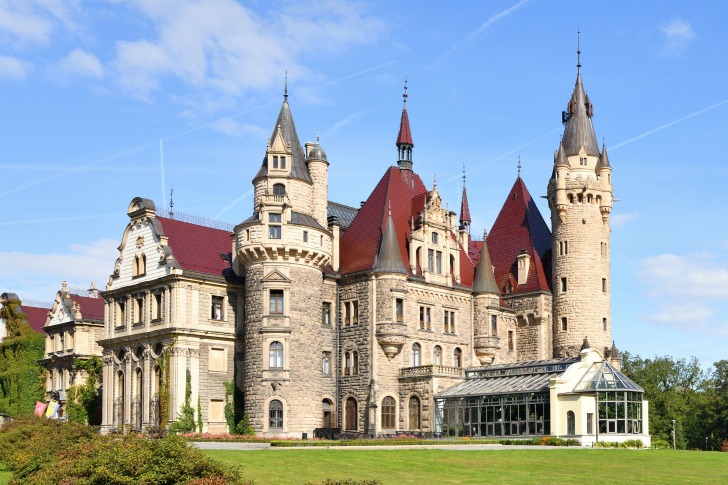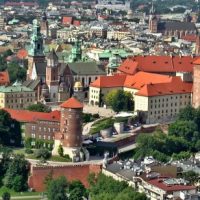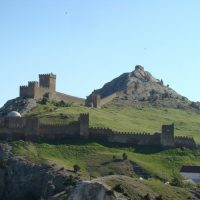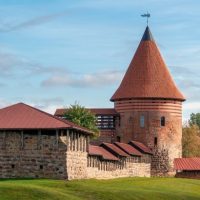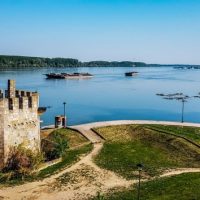Poland is a country with a 1000-year history.
As such, castles and palaces form a monumental part of the country’s identity.
There are approximately 500 castles and over 2,500 palaces, some of which are in ruins, all of which are draped in the rich history that underlies the centuries that these structures have existed.
Many of these castles have withstood wars and partitions and witnessed the transformations of Poland over the centuries through its complicated past.
In addition, Poland is home to the largest castle in Europe, Malbork Castle, which is listed as a UNESCO world heritage site.
9 Most Beautiful Castles in Poland
1. Moszna
Moszna Castle was built in the 18th century in a small village of the same name, situated in southwest Poland.
The village is located approximately 30 kilometers south of the regional capital, Opole.
Moszna Castle is akin to a fairytale castle, built with eclectic architecture.
Its center, which burnt down in 1896 and was rebuilt in the same year, is predominantly designed in Baroque architecture.
By 1900, an east wing was added in a neo-Gothic architectural style.
A west wing was added between the period 1912 to 1914 in neo-Renaissance style architecture.
The total floor space of the castle comprises 7,000 square feet.
It features 365 rooms, 99 turrets, and a chapel, which is used as a concert hall today.
The castle was the family home of a Silesian family by the name of Tiele Winckler from 1866 to 1945.
At this time, they were forced to flee and the castle became the home of the Soviet Red Army.
It has changed hands many times over the years.
Today, the castle is open to the public and attracts thousands of tourists a year.
In 1998, an art gallery was established in the castle which hosts regular art exhibitions.
2. Pieskowa Skała
Pieskowa Skała Castle is located in the valley of river Pradnick in Poland.
Pieskowa Skała is a limestone cliff.
The castle is located on this cliff and is inaccessible from three sides.
It was built in the 14th century by King Casimir III The Great, forming part of a chain of 25 fortified castles that served as a stronghold stretching from Kraków to Częstochowa.
These castles sit along a trail known as the Trail of the Eagles Nests.
It is surrounded by the beauty of the Polish Jurassic Highland or, Polish Jura.
The castle was originally built in the Gothic architectural style and transformed during the period 1542 to 1580, into the traditional Renaissance architectural style that we are familiar with today.
It is an outstanding example of defensive Polish architecture.
Bastion fortifications were added to the structure during the 17th century.
The purpose of the 25 medieval castles was to secure the southern border of the country and the capital of Poland, Krakow, against the Czech invasion.
During the period between 1308 to 1608, the castle was home to the Szafraniec family.
Over the years, the castle has changed owners many times and has served as an orphanage, a luxury bed, and breakfast, and has been serving as a museum since the 1970s, attracting thousands of tourists each year.
3. Niedzica Castle
Niedzica Castle is located in the southernmost part of Poland, in Nowy Targ County, Lesser, Poland.
The castle is known by another name: Dunajec Castle.
It is named after the Dunajec river as the castle is located approximately 300 meters upstream of the river mouth.
It sits on the banks of Lake Czorstyn.
The most majestic views of the castle are from the opposite side of the lake, from the ruins of another castle called Czorstyn castle.
Niedzica Castle is surrounded by the Pieniny mountains and was built between 1320 and 1326 by a Hungarian named Kokos of Brezovica.
It was originally built on the ruins of an ancient stronghold.
The architectural style of the castle is Gothic and most of the castle has gone to ruins with only the dungeons and a few rooms surviving.
The most recent renovations were undertaken by the Polish Ministry of Culture and completed in 1963.
The current architectural structure consists of a beautiful courtyard that is surrounded by towers, fortified walls, arcades, and residential wings.
The main structure is a dense complex of buildings.
For most of its existence, the castle has been the property of several wealthy Hungarian families, the last of which to own the castle being the Hungarian Salamon family.
Today, the castle serves as a museum and is owned by the Polish state.
4. Malbork Castle
Malbork Castle is considered to be the world’s greatest stronghold built with brick.
It is a Teutonic castle that was built in the 13th century.
It is both a castle and a fortress.
Malbork Castle is located in the north of Poland, on the east side of the Nogat river, just outside a village by the same name: Malbork.
The gigantic castle was constructed in stages.
The first stage comprised the construction of the tall castle, also known as the central bastion, which began in 1276.
In 1309, the town of Malbork became the capital of the order, and it was during this time that the significant expansion of the castle started.
The middle and lower castles were later added to the structure.
The castle is surrounded by defensive walls and deep moats.
It is the biggest castle in Europe and the world, as well as a registered UNESCO world heritage site.
The Teutonic Knights built the medieval brick castle.
These knights were of German descent and Catholic by religion.
They were religious crusaders.
The castle was home to the order for nearly a century and a half.
The castle fell as a result of decay but most of the structure was renovated in the 19h and 20th centuries.
Today, the castle is a museum and visitors may take a self-guided tour with audio headsets.
5. Wilanów Castle
Wilanów Castle is located in the Wilanów District in Poland.
It is a palace designed by the architect Augustyn Wincenty Locci and predominantly features a Baroque architectural style mixed with European art and a Polish building structure.
It is a very important Polish monument and was registered as a national historical monument on the 16th of September 1994.
The palace includes a baroque Italian garden on the eastern side of the structure.
The garden is as majestic as the palace and brings the structure to life with its geometric arrangement.
Wilanów Castle, reminiscent of Polish aristocratic mansions, features several different architectural designs, including that of a French palace, and Italian suburban mansions, as well as a few towers.
The palace was built by King John III Sobieski in the latter half of the 17th century.
It has survived both world wars as well as Poland’s partition.
Today, the palace hosts several cultural events and concerts throughout the year and it features a museum that was established in 1805.
The museum attracts upwards of three million tourists each year.
6. Castle Książ
Castle Książ is located in southwestern Poland in a city called Wałbrzych.
The castle was constructed in the 13th century by the order of Bolko I, the Duke of Lwówek.
It sits on top of a rock cliff, is surrounded by a picturesque forest, and features a mixture of Baroque, Gothic, and Rococo architectural styles.
It is the largest of its kind in the Silesia region of Poland.
King Ottokar II’s Bohemian forces destroyed the first fortification of the castle in 1263.
The most interesting fact about this castle is that it was once set to become the headquarters of Adolf Hitler after being seized by the Nazi regime during World War II.
Before that, the castle was occupied by various noble families.
It was during this period that a series of very large tunnels were constructed under the castle and the city.
Today, the castle is open to the public and serves as an important tourist attraction in Lower Silesia.
It also features a lovely hotel. Many tourists come to view the amazing architecture of the building and explore a small section of the tunnels which is also open to the public.
7. Łańcut Castle
Łańcut Castle is located in Łańcut, Poland.
The first fortified tower of the castle was constructed in the second half of the 16th century.
In 1610, the horseshoe shape of the castle was constructed.
It underwent significant renovations between 1629 and 1641.
It was during this period that the castle obtained its palace-like appearance.
The castle was home to four prominent families throughout history who were successive, the Pilecki, Stadnicki, Lubomirski, and Potocki families.
It is the masterpiece of three well-known architects; Maciej Trapola, Krzysztof Mieroszewski, and Tylman Gamerski.
Łańcut Castle is made up of several buildings and is surrounded by a beautiful park.
The town of Łańcut was founded in the late middle ages in 1349 under the rule of King Casimir the Great.
Today, the castle is open to the public for self-guided tours.
8. Baranów Sandomierski Castle
Baranów Sandomierski Castle is located in Baranów Sandomierski, in southeast Poland.
The castle was constructed in the 16th century in the Mannerist architectural style by an Italian architect known as Santi Gucci.
It is known by another name: Little Wawel. Construction of the castle took approximately 15 years.
The castle is rectangular with four bastions on each of the four corners.
It is considered to be one of the most well-preserved Renaissance castles in the country.
Throughout its existence, the castle has changed hands several times, often being in the ownership of a noble family.
The castle went into decay after World War II but was renovated shortly afterward.
Today, the castle serves as a museum for the community and tourists, as well as a hotel and conference center.
9. Czocha Castle
Czocha Castle is a defensive castle located in southwest Poland in the town of Czocha and constructed in the 13th century.
It is located near the Kwisa river on Lake Leśnia.
The castle was constructed under the orders of Wenceslaus I of Bohemia.
During the 18th century, a fire destroyed most of the castle but it was later restored to its former glory.
During World War II, much of the interior and decor was stolen by looters.
Today, the castle serves as a museum which is visited by many tourists from all over the world, as well as a hotel.
Poland Safety Overview
READ THE FULL REPORT: Poland Safety Review
Safety Index:
- OVERALL RISK: LOW
- TRANSPORT & TAXIS RISK: LOW
- PICKPOCKETS RISK: MEDIUM
- NATURAL DISASTERS RISK: LOW
- MUGGING RISK: LOW
- TERRORISM RISK: LOW
- SCAMS RISK: MEDIUM
- WOMEN TRAVELERS RISK: LOW
Frequently Asked Questions
Does Poland have a King and Queen?
No.
The monarchy was abolished in 1918.
Can you stay in a castle in Poland?
Yes, for €45 you can book a room in Zamek Czocha Castle.
What is the most famous castle in Poland?
Wawel Castle.
Who was the last royal of Poland?
Stanisław II August.
